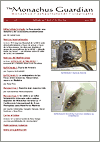Press Watch, Honolulu Star Bulletin, April 16, 2010

The state Department of Land and Natural Resources is investigating the apparent drowning of a 9 1/2 -month-old Hawaiian monk seal that was discovered tangled in a gillnet—the sixth such death since 1976.
At 10:26 a.m. Tuesday, the female monk seal, identified by scientists as RA14, was spotted floating off Bellows Beach. Lifeguards discovered the seal wrapped in a monofilament gillnet and pulled her from the water.
Necropsy results determined the seal, nicknamed Mikala, died of an apparent drowning due to the entanglement. […]
The Conservation and Resources Enforcement Division seized the netting as part of its investigation. It is unknown who owns the net.
Under state law all lay nets must be registered with the Department of Land and Natural Resources. It is unlawful to leave a lay net unattended for more than a half-hour. Nets also must be inspected within two hours after they are set.
Hawaiian monk seals are protected under the U.S. Endangered Species Act. Killing one is punishable by up to a year in jail and a $50,000 fine. […]

 Thanks to the support of the Government of the Balearic Islands, Spain, the June 2009 issue of The Monachus Guardian has now been published in Spanish. (Publication of the November 2009 issue will follow shortly.)
Thanks to the support of the Government of the Balearic Islands, Spain, the June 2009 issue of The Monachus Guardian has now been published in Spanish. (Publication of the November 2009 issue will follow shortly.)
